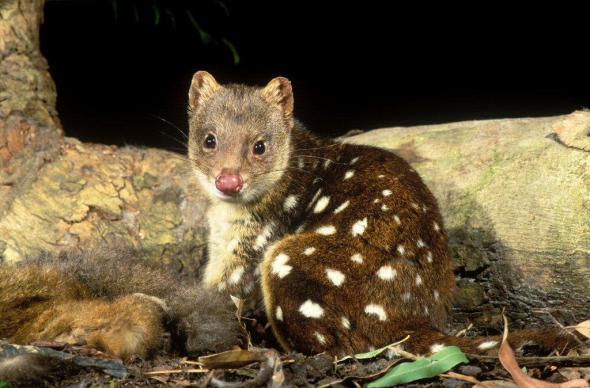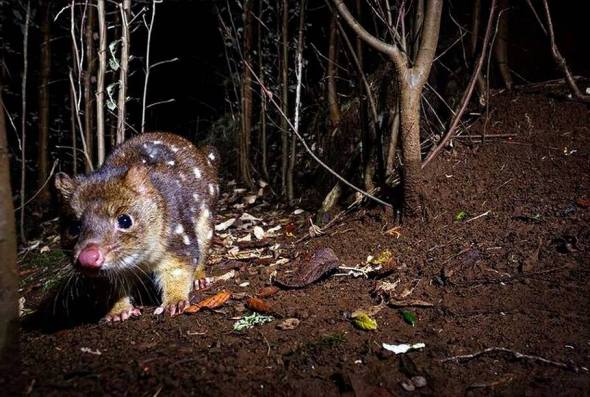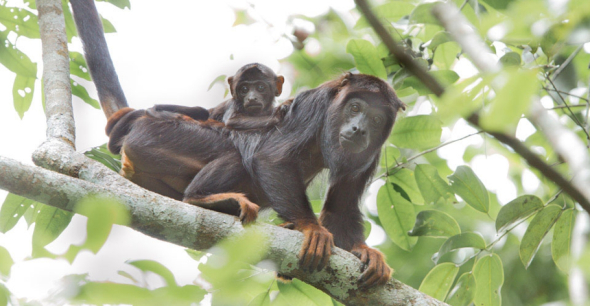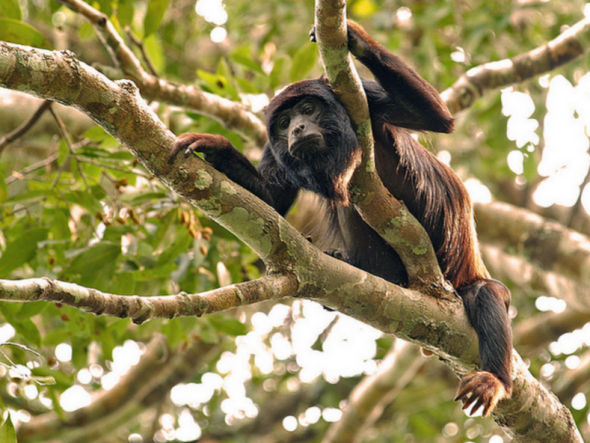Endangered Species Monday: Dasyurus maculatus
Endangered Species Monday: Dasyurus maculatus
This Mondays Endangered Species Watch Post (ESP) I focus a little attention onto the Spotted-tailed Quoll. D. maculatus was identified back in 1792 by Dr Robert Kerr (1755 – 11 October 1813) Dr Kerr was a scientific writer and translator from Scotland. Dr Kerr was born in Roxburghshire as the son of a jeweler. He studied medicine at the University of Edinburgh and practiced at the Edinburgh Foundling Hospital as a surgeon. (Image adult Quoll)
Dr Kerr translated several scientific works into English, such as Antoine Lavoisier’s work of 1789, In 1792, he published The Animal Kingdom, the first two volumes of a four-tome translation of Professor Linnaeus’ Systema Naturae, which is often cited as the taxonomic authority for a great many species. (He never did start the remaining two volumes.) Please note, the Spotted-tailed Quoll is described as ‘two subspecies’ and will be noted as such during this short article.
Listed as near threatened, D. maculatus has been wrongly named by some writers as the ‘Tiger Quoll’. The species shows no resemblance to that of a Tiger nor shows any familiar behavioral traits too. There is no mention of a ‘Tiger Quoll’ within conservation literature too. So I wish to put that name to bed now.
From 1996 the species [and sub-species] was listed as vulnerable, a further 2008 evaluation of the carnivorous marsupial saw conservation NGO’s submit data to the Red List of which the Spotted-tailed Quoll now qualifies for the criteria of (near threatened). Endemic to the island of Australia the species exists as explained as two sub-species.
Sub species (1) Dasyurus maculatus maculatus was formerly distributed in south-eastern Queensland (as far north as Bundaberg and as far west as Chinchilla), eastern New South Wales, Victoria, South Australia, Tasmania (including some of the Bass Strait Islands. Maxwell et al. (1996) reported that in south-east Queensland this particular sub-species has undergone a range contraction indicated to be in excess of 30% over the last 25 years and is now rare in most areas.
Sub species (2) D. m. gracilis formerly occurred throughout the latitudinal range of the Wet Tropics World Heritage Area of north Queensland. It is now apparently extinct from the Atherton and Evelyn Tablelands, and there are few sightings south of 17o45’S. This represents a decline in extent of occurrence of approximately 20%.
Populations are decreasing of which there remains an estimated ‘20,000’ mature individuals. Populations in south-east Queensland, western Victoria (Otways and far south-west of Victoria), and coastal areas of southern New South Wales are known to be declining too. Populations in north-eastern Queensland are small, fragmented, and are <1,000 individuals. Tasmanian population numbers appear to be stable.
There is some evidence of a decline in distribution or in numbers in remaining suitable habitat (e.g., in the Otway Range), and the species is mostly uncommon (although it is present in good numbers in some areas, such as the Marengo and Chaelundi Forests).
Image: Spotted-tailed Quoll (juvenile)
Threats
The reasons for decline of D. m. maculatus are a combination of habitat loss and fragmentation, possible disease at the beginning of the 20th century, competition with foxes and feral cats, predation by foxes and dogs, and impact of widespread strychnine baiting for dingoes.
Most recently threats include non-target mortality from trapping and poisoning (there is a long-standing concern that Quolls are being killed by the use of 1080 poisoning, but this has not been confirmed and is currently the focus of a number of investigative trials).
Direct persecution is significant as they are attracted to caged birds and do not necessarily take flight when discovered. Estimated forest loss as a result of clearing within its former range in south-east Queensland is over 70%, with the majority of loss occurring over the last 20 years.
The species uses a large number of den sites throughout the year and activities that reduce the number of den logs are likely to be significant. In Tasmania this taxon is naturally rare, possibly as a result of competition with D. viverrinus, Sarcophilus harrisii, and feral cats. Road mortality could be a significant factor where high speed roads and good habitat coincide, as Quolls are attracted to feed on the carcasses of road-killed animals.
D. m. gracilis is susceptible to factors which increase juvenile and/or adult mortality, or which otherwise decrease breeding success. Such factors may include habitat clearance, logging, introduced species including cane toad, and direct killing at chicken pens, at houses, and on roads.
Conservation actions are underway with more planned soon that will work to evaluate the current species size, habitat loss, food sources and protective areas needed Etc.
Spotted-tailed Quolls are generally nocturnal and rest during the day in dens. However, juveniles and females with young in the den can be seen during the day and may leave their dens when it is light out. Quoll dens take the form of underground burrows, caves, rock crevices, tree hollows, hollow logs, or under houses or sheds. Quolls move by walking and bounding gaits. Trails are not particularly important for Quoll, although they forage and scent mark along runways and roads.
Facts
Size of the Quoll depends on the species. They can reach 14 to 29.5 inches in length and 3 to 15.4 pounds of weight.
Quoll is covered with coarse coat that can be grey, brown or black in color. Basic color of the fur is enriched with prominent white spots. Quoll has pointed snout and pink nose. Its powerful jaw is equipped with sharp teeth. Tail is long and bushy. Quoll has sharp claws on the front and hind feet that are used for holding the food, climbing and digging underground burrows.
Quolls are nocturnal animals (active during the night). Even though Quolls are agile climbers, they spend majority of their life on the ground. Quolls can consume both animals and plants. Diet is mainly based on small mammals (such as rabbits), small birds, snakes and insects. They occasionally eat fruit and nuts.
Main predators of Quolls are crocodiles and snakes. Quolls live in the underground burrows, inside the hollow trees or caves. Quoll is territorial animal.
Male’s territory overlaps with territories of several nearby females. They share communal latrines. Quoll is solitary creature which gathers with other Quolls only during the mating season.
Mating season of Quolls takes place during the winter. Pregnancy lasts only couple of weeks and ends with up to 30 miniature babies (they weigh less than one gram).
Babies spend first 8 weeks of their life inside the mother’s pouch. After that period, babies are big enough to leave the pouch and ride on the mother’s back. Young Quolls are ready for independent life at the age of 6 months. Female’ pouch is not a true pouch. It forms out of the fold of skin on the stomach after successful mating. Pouch contains only 6 teats, which means that only 6 babies out of 30 will be able to survive and complete their development. Quolls reach sexual maturity at the age of one year. Quolls have short lifespan. They can survive from 2 to 5 years in the wild, depending on the species.
Contrary to popular belief Quolls or as some people refer to this documented species as the ‘Tiger Quoll’ are not rare. The species and entire genera are in fact nocturnal, so while your asleep they’ll most likely be happily wondering through your garden or local parks and nature reserves. However the species is threatened and decreasing with a population size of some 20,000.
Thank you for reading.
Dr Jose Depre.
Don’t forget to check out the upcoming Embassy Day hosted by SAYNOTODOGMEAT.NET please click the link here below further information > http://saynotodogmeatevents.info/2015/07/26/embassy-day-september-17th-2015/
Endangered Species Monday: Alouatta belzebul.
Endangered Species Monday: Alouatta belzebul
This Monday’s endangered species article from the (Endangered Species Watch Post) focuses on the Red Handed Howler Monkey of which is listing near to endangerment. (Image Red Handed Howler Monkey)
Generically identified as Alouatta belzebul back in 1766 by Professor Carl von Linnaeus (1707 – 10 January 1778), also known after his ennoblement as Carl von Linné was a Swedish botanist, physician, and zoologist, who laid the foundations for the modern biological naming scheme of binomial nomenclature.
Listed as vulnerable the species is endemic to Brazil (Alagoas, Maranhão, Pará, Paraíba, Pernambuco, Rio Grande do Norte, Sergipe and Tocantins). Populations are currently on the decline of which its very likely the species will be re-categorized as endangered within the next five years, if not sooner.
A. belzebul is said to be extremely common in some areas such as Marajó however is noted as rare within the Atlantic Forest portion of the range known as; Rio Grande do Norte, Alagoas, Paraíba and Pernambuco. Last survey census’s reported the species to be inhabiting at least ten isolated locations of which two hundred individuals remain in each plot.
International Animal Rescue Foundation Brazil have for the past three years been conducting surveys within the area will be submitted to the (IUCN). Furthermore the Environmental Protection Unit now re-based in Londrina are working with local communities, hunters and farmers within the A. belzebul range to preserve commonly known species of monkey, birds, amphibians and flora within the region.
IARFB are also currently conducting investigations to locate where sugar cane is being exported too and used within from the A. belzebul’s region. Its believed that America, Mexico, South America, and Europe are purchasing large sugarcane exports from the region. Tesco, J.S Sainsbury’s, Cooperative Food Group, Asda, Walmart, Woolworths and Spar have all been noted on suppliers exports from the regions. Aldi, Lidl, Quick-Save, Budgens have been ruled out. We are least impressed though with J.S Sainsbury’s name written on export documents of sugar cane from the region.
Within the ten isolated locations six populations are known to reside in Paraiba, two in Rio Grande de Norte, one in Pernambuco, and one in Alagoas. The largest population in the Atlantic Forest is in Pacatuba in Paraiba with about 80 animals. There have been five registered local extirpations from forest fragments in the last 50 years.
Little known conservation actions are under way within their endemic region and as explained populations are decreasing and nearing endangerment. A. belzebul is listed within the family of Atelidae which is one of the very first five of new recognized ‘new world monkeys’. Its quite likely that new sub-species of the Red Handed Howler Monkey may be located as well as newer species of ‘new world monkeys’ too within the coming years. Only five years ago did scientists locate over 100,000 new species within the Yasuni National Park, Ecuador so in reality anything is possible.
The Atelidae family host howler, spider, woolly and woolly spider monkeys (the latter being the largest of the New World monkeys). They are found throughout the forested regions of Central and South America, from Mexico to northern Argentina.
When the species is not foraging on the ground floor they can normally be found resting in the canopies of trees at a height of some sixty feet. Social groups normally consist of seven to twenty members that will host mature males, females juveniles and infants. Males normally take lead of the pack or (troop).
These large and slow-moving monkeys are the only folivores of the New World monkeys. Howlers eat mainly top canopy leaves, together with fruit, buds, flowers, and nuts. They need to be careful not to eat too many leaves of certain species in one sitting, as some contain toxins that can poison them. Howler monkeys are also known to occasionally raid birds’ nests and chicken coops and consume the eggs.
Image: Adult Red Handed Howler Monkey.
Howlers are the only New World primates which regularly include mature leaves in their diet, although softer, less fibrous, young leaves are preferred when they are available. Their folivory and ability to eat mature leaves is undoubtedly one of the keys to their wide distribution and the wide variety of vegetation types they inhabit.
Mature fruit is the other important food item, especially wild figs (Ficus) in many regions, but they also eat leaf petioles, buds, flowers (sometimes seasonally very important), seeds, moss, stems and twigs, and termitaria. The diet of two A. belzebul groups in the Caxiuanã National Forest was studied by Souza et al. (2002). They were largely folivorous but would switch to fruits whenever available, especially during the wet season.
Size:
Adult male weight 7.27 kg (n=27),
Adult female weight 5.52 kg (n=26)
Adult male weight 6.5-8.0 kg (mean 7.3 kg, n=27),
Adult female weight 4.85-6.2 kg (mean 5.5 kg, n=26) .
Threats
Listed on Cites Appendix II there are few threats associated with the species. Nevertheless they still remain and if left unchecked can rapidly increase placing the new world monkey in danger of extinction.
In the Amazon, the species is widespread, although they are hunted. The Amazon populations have suffered severely from forest loss throughout their range in southern Pará over the last decade. In the Atlantic Forest population, the major threat is the fragility of the remaining small forest patches to stochastic and demographic affects (habitat loss and fragmentation has been mainly due to sugar-cane plantations).
Please share and make aware the Red Handed Howler Monkey’s plight. Tip: Check sugar products from local shops and hypermarkets to ensure your not aiding the destruction of their natural habitat via your sugar purchase. Check your local candy and other shopping supplies. If necessary contact companies politely asking where they are obtaining the sugar products from. Never give up.
Thank you for reading.
Dr Jose C. Depre.
Environmental and Botanical Scientist.
Chief Executive Officer






